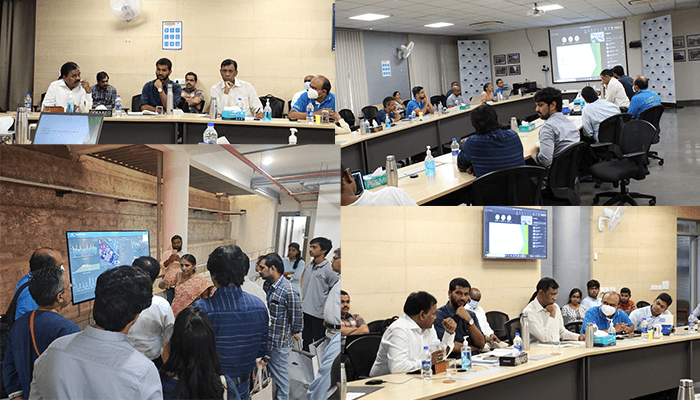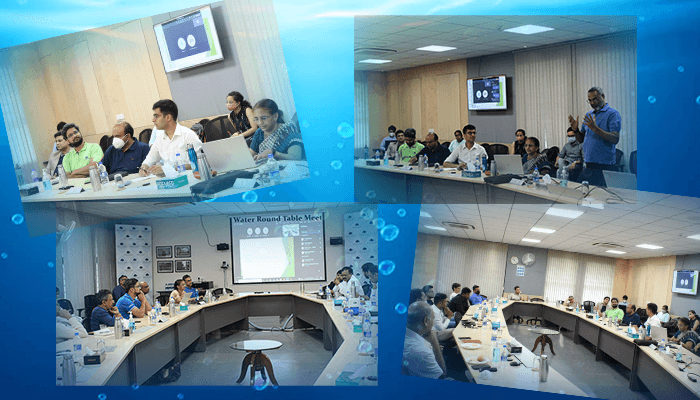A roundtable conference by IIITH’s Smart City Research Centre on Environmental Social Governance (ESG) deliberated on climate change and ideas to retrofit technology across institutions, to strengthen our environment and societies.
An alarming effect of climate change is wet bulb temperature that many parts of India reported during the heat wave that swept the nation this year. This refers to the phenomenon where it is difficult to withstand temperatures, even as low as 24°- 35°C, when a combination of humidity and heat hampers the human body’s natural ability to cool down with perspiration. Increased humidity, urban heat island and global warming triggered this effect in Hyderabad at 35°C.
Environmental Social Governance (ESG) is the ideological lodestone when measuring the sustainability and ethical impact of investment in an enterprise. The term is used to identify matters that are traditionally associated with sustainability and corporate responsibility, focusing on its impact on the environment and wider society.

Roundtable conference on ESG in Smart cities
Hosted by IIITH’s Smart City Living Lab on 24 June 2022, the Round table looked at the current state of technology, opportunities and challenges in research and industry. “Although everyone is aware of ESG, we are not fully prepared to measure and track related metrics or develop actionable plans to mitigate ESG risks”, notes Prof Ramesh Loganathan, who set the context for the discussion. Moderated by Viivek Varma of Recykal Foundation, the intellectual capital was drawn from government, technology partners, academia, NGOs and start-ups including Amara Raja, EBTC, GMR, ISHRAE, JLL Energy, CEGIS, Bintix, SAP, IKP, faculty and students of IIITH.
Discussion centred around ESG responsive areas, use cases and types of solutions to build smart cities-compatible technology in a robust manner and to derive insights into how cities, governments and technology players are responding to sustainability requirements.
Systems for technology to capture Scope 1, 2 & 3 emissions on real time basis as well as the ease of reporting all emissions by technology/digital companies, without manual intervention were analysed. Various sustainability measures and scores, range of technologies & innovations at play and how they could be interwoven into a larger fabric were looked at, along with checks and measures for accountability at the individual and organisational level.
Climate change, Solution areas, use cases and types of solutions
Human-induced climate change is broadly bucketed into those that affect ecosystems and those having a direct effect on human systems. Some changes are beyond the ability of humans and ecosystems to adapt, like wet bulb temperatures that is being globally experienced this year.
This makes the strongest case to demand more action from businesses and governments to implement net-zero emissions measures, and for companies to deliver the technology that will help scale decarbonisation. Embedding ESG metrics into one’s portfolio may also be an effective tool in risk management, enhance resilience and tap into green innovation for long-term capital growth. The criterion also helps to ensure that internal processes are socially and environmentally sustainable.
Undo the creativity that once increased productivity
Over the last decade, large scale automation of several processes helped to increase productivity and profits, without considering its ecological and social repercussions, to the extent that the environment is now on the verge of collapse. We cannot turn back the clock but it is in our hands to implement ESG guided sustainable practices at the individual and industry level.
Answer lies in Life Cycle Assessment
Life Cycle Assessment (LCA) helps businesses to measure and quantify the end-to-end environmental and economic impact of a product, process or service. It enhances the brand value for competitive differentiation and thus must be closely monitored. A circular economy for materials is an important aspect that companies developing new products should consider. ESG policies are to be holistically designed to minimise wastage and enable reuse and recycling.
Strategy-led Zero tolerance policy
The three zeros – zero wastage, zero emissions and zero inequality will be key factors in improving overall efficiency. Large scale deployment of renewables will reduce import dependency, meet national goals of decarbonisation and enhance energy security in the medium-to-long term. For India to reach its 350 GW solar energy target by 2030, innovations are needed to improve solar panel efficiency that currently stand at 20%. Innovative new technologies like building integrated and flexible photovoltaics and alternative energy sources should be explored in the Indian market.
Jugaad – Technologies & Innovations at play
Finding indigenous innovation for Indian problems will be the key driver in the Indian context. Technological policies and incentivizing sustainable solutions will be impactful to businesses and will amplify environmental consciousness among the common man. India’s diversity demands going vocal for local and finding means that are unique to the region and easily adaptable. New cities will have to be designed with new perspectives, keeping in mind technologies that fuel growth while engineering a leaner, cleaner environment.
Stellar recommendations for the path forward
- Utilizing existing products. Modify or customize available products after assessing their ESG value chain by using existing software programs/products.
- Defining a holistic scoring pattern. While establishing the criteria for setting up the ESG market, standardize scoring patterns by taking into consideration, factors like existing technologies, regions, processes, ingredients and people involved. For instance, apart from Co2 emissions, other criteria to be considered for environmental impact would be recycling waste by-products.
- Data management and transparency. How can ESG metrics be effectively embedded at all levels of operation to ensure maximum transparency? The challenge lies in translating data from across the platform into an understandable format to instil awareness and emphasize its importance to the public.
ESG as the common denominator
- Accelerating the harnessing of alternate renewable energy sources like solar and wind will reduce dependence on natural gas for electricity and also benefit electricity-based vehicles.
- Creating an environment health record for an individual or company will chart their contribution towards environment.
- Governance at different levels should enforce strict policies to mandate ESG compliance and to embed it as a habit into individuals and companies in that region.
- Easy availability of Service Providers – Individuals/companies should not have to worry about logistics involved in implementation of sustainability practises.
- A multi-media blitzkrieg via social network – Committing to socially and environmentally equitable practices may seem overwhelming to the common man and business. Proper communication of the guiding principles and measures of ESG will help make social commitments actionable and demonstrate benefits in the long term.
- Smarter business and measurable value – The economic spin off can play a vital role by providing incentives for individuals to change their behaviour. Awarding penalties/incentives to companies/individuals based on their contribution to ESG and applying higher price points for components which are not ESG compatible, should be strictly enforced by governance at all levels.
- Data privacy and security – When data-driven ESG becomes a core component of your business process, you are creating a model that will have measurable value. For instance, a flight booking platform could show flights based on how sustainable they are, based on the collected data.
Paramount to the success of embedding ESG into society is gaining customer confidence that their data is secure and private. Only then will customers be willing to accept the implementation of new ideas and technologies involving sensors that collect the individual’s daily data.
Getting all hands on deck
How do you level the playing field? More than ticking boxes, the path ahead is to bring the spectrum of technology solution providers and stakeholders to a common platform, aligned with ESG goals. A white paper captured the summary of findings with an actionable strategy. The game plan is to initiate industry-led research with specific project possibilities from participating stakeholders.



Next post